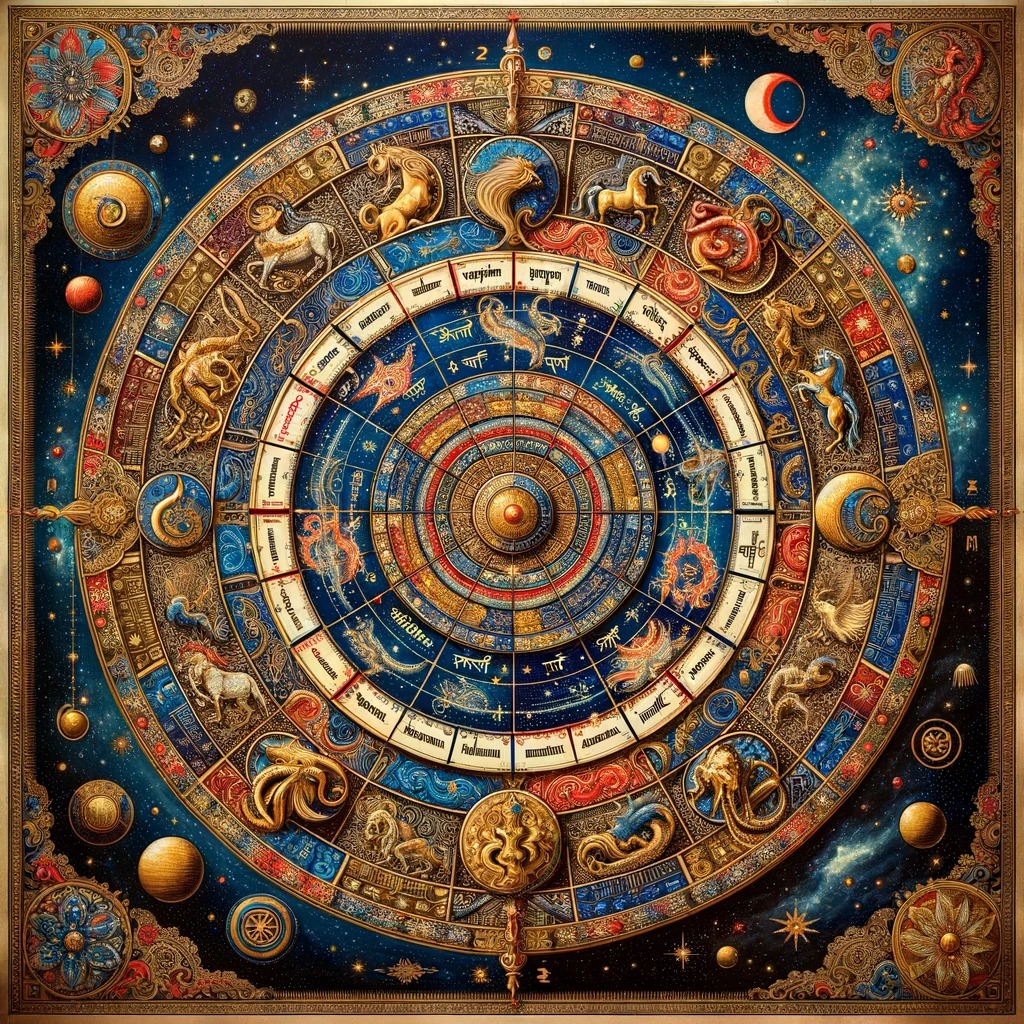Exploring the 27 Nakshatras in Vedic Astrology
 April 28, 2024
April 28, 2024 Table of Contents
Introduction
The Nakshatras, or lunar mansions, are fundamental components of Vedic astrology, deeply influencing human fate through their specific energies and attributes. Each of the 27 Nakshatras marks a specific area of the sky, defining unique characteristics and effects as the Moon transits through them. This blog explores each Nakshatra, unveiling their deities, symbols, and the roles they play in our lives, offering insights into how these celestial forces shape our destinies.
Ashwini
Situated at the very beginning of the zodiac in Aries, Ashwini is ruled by Ketu and symbolized by a horse’s head, representing speed and agility. Governed by the Ashwini Kumaras, this Nakshatra embodies the qualities of healing and swift action, making its natives quick and revitalizing. Ashwini’s energy is pioneering, ideal for beginnings and rapid recoveries.
Bharani
Bharani, ranging from 13°20′ to 26°40′ in Aries, falls under the dominion of Venus and is symbolized by the yoni, representing creation and destruction. Its ruler, Yama, the god of death, imparts to Bharani themes of transformation and control. Bharani natives are known for their strong character and tenacity, often dealing with life’s profound changes.
Krittika
Straddling the end of Aries and the beginning of Taurus, Krittika is influenced by the Sun and represented by a razor or flame. Its association with Agni, the fire god, speaks to purification and power. Krittika is about spiritual warriorship, cutting through deceit with its sharp edges, making its natives bold and brave.
Rohini
Occupying a significant portion of Taurus, Rohini is beloved by the Moon and symbolized by a chariot. It exudes fertility, growth, and development, governed by Brahma, the creator. Rohini’s natives are often attractive, prosperous, and successful, blessed with a stable and comfortable life.
Mrigashirsha
Extending from the end of Taurus into Gemini, Mrigashirsha is under Mars’s sway and symbolized by a deer’s head. It represents searching and questing, driven by its ruler, Soma, the Moon god. This Nakshatra blesses its natives with curiosity, versatility, and a restless spirit, constantly seeking knowledge.
Ardra
Found entirely within Gemini, Ardra is ruled by Rahu and symbolized by a teardrop, signifying renewal after a storm. Its association with Rudra, the storm god, brings transformative energy, often through upheaval. Natives of Ardra can expect periods of significant change and regeneration, leading to new insights.
Punarvasu
Spanning the end of Gemini and the beginning of Cancer, Punarvasu is influenced by Jupiter and symbolized by a quiver of arrows. It is associated with Aditi, the mother of gods, which gives the energy of renewal and restoration. Punarvasu natives are known for their resilience and ability to bounce back from adversity.

Pushya
Located in Cancer and ruled by Saturn, Pushya is symbolized by the udder of a cow, representing nourishment and care. Governed by Brihaspati, the teacher of gods, Pushya is considered one of the most auspicious Nakshatras, fostering growth, nurturing, and spiritual leadership.
Ashlesha
Ashlesha, located entirely within Cancer, is ruled by Mercury and symbolized by the serpent. It is linked to the Nagas, serpent deities representing wisdom and danger. Ashlesha natives are often insightful and intense, with a knack for delving into the mysteries of life. They can be secretive and transformative.
Magha
Situated in Leo, Magha is ruled by Ketu and symbolized by a royal throne. Its association with the Pitris, or ancestral spirits, underscores themes of heritage and power. Magha natives are proud, regal, and authoritative, with a strong sense of tradition and respect for the past.
Purva Phalguni
This Nakshatra, also in Leo, is governed by Venus and symbolized by the front legs of a bed, representing relaxation and enjoyment. Its deity, Bhaga, governs prosperity and marital bliss. Purva Phalguni natives enjoy the arts and pleasures of life, often blessed with creative talents.
Uttara Phalguni
Extending from Leo into Virgo, Uttara Phalguni is ruled by the Sun and symbolized by the back legs of a bed. It is associated with Aryaman, the god of contracts and unions, emphasizing relationships and agreements. Its natives are balanced, ethical, and humanitarian.
Hasta
Occupying the heart of Virgo, Hasta is ruled by the Moon and symbolized by a hand. It represents skill and craftsmanship, overseen by Savitar, the Sun god, granting creativity and dexterity. Hasta natives are cheerful and skilled in the arts and crafts.
Chitra
Spanning the end of Virgo and the beginning of Libra, Chitra is influenced by Mars and symbolized by a bright jewel or pearl. Its deity, Tvashtar, the celestial architect, endows beauty and architectural skills. Chitra natives are artistic, attractive, and effective communicators.
Swati
Located in Libra, Swati is ruled by Rahu and symbolized by a young plant swaying in the wind. Its deity, Vayu, the wind god, imparts movement and independence. Swati natives are independent, adaptable, and resilient, often thriving in changing conditions.
Vishakha
This Nakshatra stretches from Libra into Scorpio and is ruled by Jupiter. It is symbolized by a decorated gateway, representing triumphant achievements. Its deities, Indra and Agni, signify energy and success. Vishakha natives are determined, goal-oriented, and successful in their endeavors.
Anuradha
Situated in Scorpio, Anuradha is ruled by Saturn and symbolized by a lotus, representing friendship and cooperation. Its deity, Mitra, the god of friendship, emphasizes collaboration. Anuradha natives are loyal, devoted, and supportive, often thriving in partnerships.
Jyeshta
Also in Scorpio, Jyeshta is ruled by Mercury and represented by an umbrella, symbolizing protection and seniority. Its deity, Indra, the king of gods, underscores authority and courage. Jyeshta natives are protective, powerful, and possess a regal demeanor.
Mula
Beginning the Sagittarius series, Mula is ruled by Ketu and symbolized by a bunch of roots tied together, representing foundation and destruction. Its deity, Nirriti, a goddess of dissolution, suggests transformation. Mula natives are insightful but may encounter upheavals in life.
Purva Ashadha
Located in Sagittarius, Purva Ashadha is governed by Venus and symbolized by a fan or winnowing basket, indicating purification and victory. Its deity, Apah, goddess of water, bestows emotional strength. Purva Ashadha natives are invincible in their pursuits, often achieving their goals.
Uttara Ashadha
Extending from Sagittarius into Capricorn, Uttara Ashadha is ruled by the Sun and symbolized by an elephant’s tusk, representing wisdom and strength. Its deities, the Vishvadevas, universal gods, impart integrity and success. Uttara Ashadha natives possess unbreakable resolve and moral rigidity.
Shravana
Occupying Capricorn, Shravana is governed by the Moon and symbolized by an ear, representing learning and comprehension. Its deity, Vishnu, the preserver, emphasizes connectivity and understanding. Shravana natives are often educators, scholars, and communicators.
Dhanishta
Spanning the end of Capricorn and the beginning of Aquarius, Dhanishta is influenced by Mars and represented by a drum or flute, signifying rhythm and reliability. Its deities, the Vasus, elemental gods, endow charisma and prosperity. Dhanishta natives are dynamic, vibrant, and generous.
Shatabhisha
Located entirely within Aquarius, Shatabhisha is ruled by Rahu and symbolized by an empty circle, representing the mysterious and the unknown. Its deity, Varuna, the god of cosmic laws, imparts healing abilities. Shatabhisha natives are private, profound, and often involved in healing or medical professions.
Purva Bhadrapada
This Nakshatra extends from Aquarius into Pisces, governed by Jupiter and symbolized by the front legs of a funeral cot, indicating transformation and fire. Its deity, Aja Ekapada, a one-footed goat-god, signifies mysticism and enlightenment. Purva Bhadrapada natives are spiritual seekers, often exploring the deeper meanings of life.

Uttara Bhadrapada
Located in Pisces, Uttara Bhadrapada is ruled by Saturn and symbolized by the back legs of a funeral cot, representing stability and wisdom. Its deity, Ahirbudhnya, a serpent of the deep sea, imparts introspection and fortitude. Uttara Bhadrapada natives are calm, wise, and compassionate.
Revati
Also in Pisces, Revati is governed by Mercury and represented by a fish swimming in the ocean, symbolizing journey and transcendence. Its deity, Pushan, the nurturer, is the protector of flocks and herds, guiding souls to the otherworld. Revati natives are empathetic, intuitive, and often drawn to caring professions.
Abhijit
This intercalary Nakshatra, not always included in standard lists, lies between the last part of Uttara Ashadha and the early part of Shravana. It is considered highly auspicious and is associated with Vishnu. Abhijit imparts success and victory, often used for electing auspicious times.
Harness the Power of Nakshatras with PocketPandit
For those looking to experience into the intricate world of Nakshatras, PocketPandit offers an exceptional tool, PocketSoft, tailored specifically for astrologers and astrology enthusiasts. PocketPandit leverages its own cutting-edge technology that seamlessly blends with Vedic astrology to provide instant, real-time digital predictions. Whether you’re an experienced astrologer or just starting your journey in astrology, PocketSoft simplifies the complex calculations involved in determining Nakshatras, enhancing both understanding and accuracy. If you have any astrological questions or need a quick prediction, simply visit pocketpandit.com/ask or install the PocketPandit app to access personalized insights at your fingertips.
Conclusion:
The 27 Nakshatras, as explored in this detailed guide, represent more than just segments of the sky; they are profound symbols of cosmic influence that define the very fabric of Vedic astrology. Each Nakshatra, with its unique deity, symbol, and characteristics, offers a lens through which we can view our personalities, life events, and even our destinies in clearer light. They teach us about the rhythm of the cosmos and how its subtle energies govern the dynamics of life on Earth.
Understanding Nakshatras allows us to align more closely with the celestial forces, guiding our actions, decisions, and spiritual path. It enhances our awareness of the natural cycles, promoting a harmonious existence that resonates with the universe’s inherent order. Through the study of Nakshatras, we gain insights into our strengths and weaknesses, enabling us to maximize our potential and navigate challenges more effectively.
The knowledge of Nakshatras also enriches the practice of astrology, providing a deeper, more nuanced understanding of astrological charts. It aids in everything from choosing auspicious dates and understanding relational compatibilities to spiritual practices and personal growth endeavors. In essence, Nakshatras connect us to the divine dance of the planets and stars, reflecting their profound impact on our terrestrial journeys.
In conclusion, the study of Nakshatras is an invitation to deepen our connection with the universe, encouraging us to live in tune with its timeless rhythms. By embracing the wisdom of Nakshatras, we embrace a life more aligned with cosmic laws, enriched with spiritual insights and enhanced by a deeper understanding of the celestial forces at play. It is a path not just to astrological insight but to living a life that is vibrantly in sync with the universe itself.
Up Next: Understanding Ashwini Nakshatra: A Comprehensive Exploration
Explore Our Previous Blog:Understanding Venus Mahadasha: Embracing Love, Harmony, and Prosperity
Connect with PocketPandit Everywhere!
Discover the magic of Vedic Astrology with Pocket Pandit across all your favorite platforms! Get detailed insights, practical remedies, and fascinating content on zodiac signs, nakshatra, yogas, and planetary movements tailored just for you. Whether you enjoy fun reels, quick tips, or in-depth videos, we’ve got something for everyone. Let astrology become a part of your journey,simple, engaging, and full of knowledge.
Join us now:




